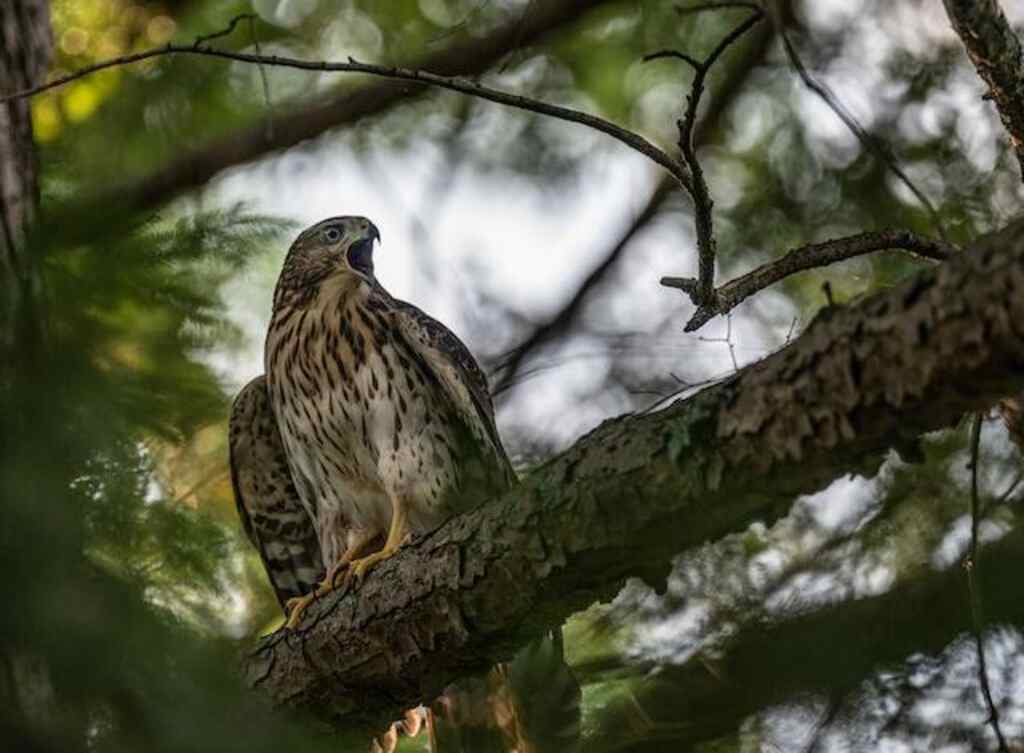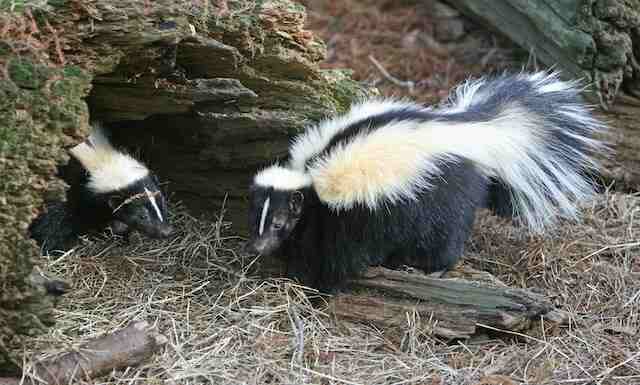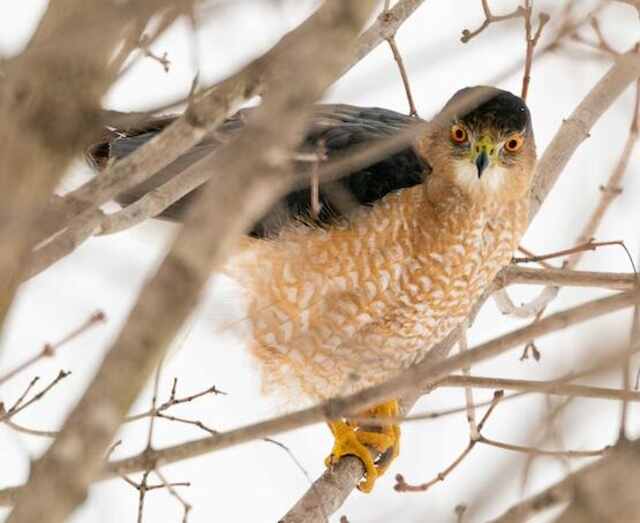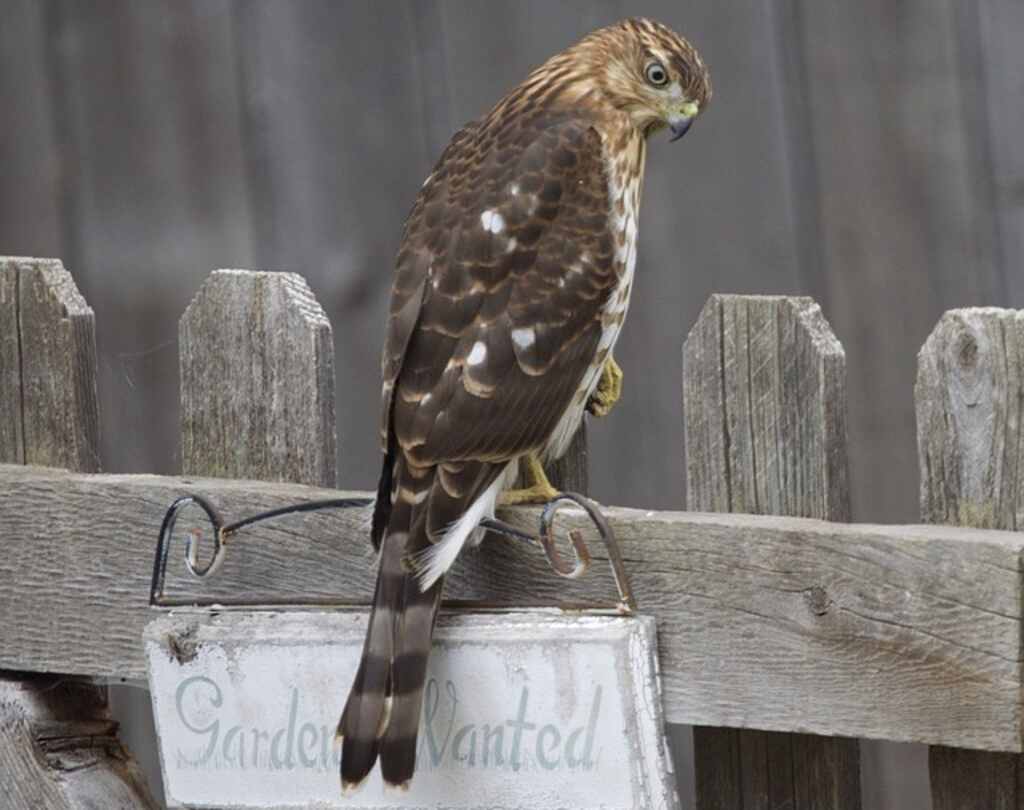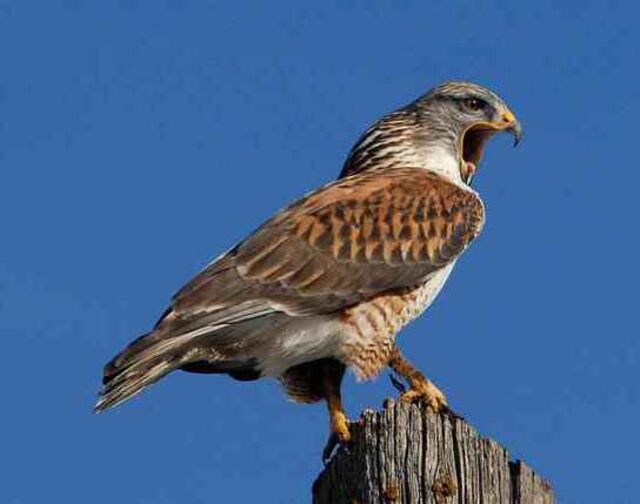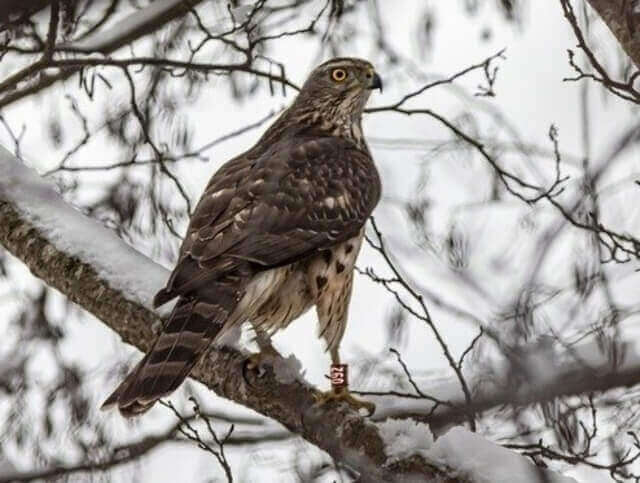Hawks and skunks are often considered as two very different species. Hawks are birds of prey, known for their sharp talons and exceptional eyesight, while skunks are small, nocturnal mammals with a distinct black-and-white fur pattern.
However, little is known about the relationship between these two animals in the wild.
One question that often comes up is “Do hawks eat skunks?”
This article aims to provide an in-depth investigation into this topic by exploring the biology and behavior of both hawks and skunks.
We will delve into the diet and hunting habits of hawks, as well as the types of skunks found in North America and their unique defense mechanisms.
Ultimately, we will seek to answer the question: do hawks really eat skunks?
Table of Contents
- 1 Explanation of Topic
- 2 Brief Overview of Hawks and Skunks
- 3 Hawks: A Closer Look
- 4 Skunks: A closer look
- 5 The Relationship Between Hawks and Skunks
- 6 Why Do Some Hawks Eat Skunks?
- 7 Competition with Other Predators
- 8 Conclusion
- 9 FAQs: Do Hawks Eat Skunks?
- 9.1 Can hawks eat skunks?
- 9.2 Why would hawks eat skunks?
- 9.3 Are skunks a preferred prey for hawks?
- 9.4 Do all species of hawks eat skunks?
- 9.5 Are skunks a significant part of a hawk’s diet?
- 9.6 How do hawks overcome the skunk’s defense mechanisms?
- 9.7 Are there any risks for hawks when eating skunks?
- 9.8 How often do hawks encounter skunks as prey?
- 9.9 Do skunks pose a threat to hawks?
- 9.10 How does human activity affect the interaction between hawks and skunks?
- 10 Author
Explanation of Topic
Many people have wondered if it is possible for hawks to prey on skunks due to their size difference and conflicting lifestyles.
Hawks are typically associated with hunting smaller animals such as mice or rabbits, while skunks primarily feed on insects such as beetles or grasshoppers.
Nevertheless, there have been instances where people have witnessed hawks attacking or consuming skunks.
This topic has been a subject of debate among wildlife enthusiasts for years, with no clear answer until now.
With this article’s investigation, we hope to provide clarity on this topic by analyzing both predator’s feeding patterns more closely.
Brief Overview of Hawks and Skunks
Hawks come in various sizes, ranging from small kestrels that weigh less than half a pound to massive eagles weighing over 10 pounds.
They belong to the Accipitridae family along with eagles, buzzards, kites, harriers, ospreys, and vultures.
Their razor-sharp talons and keen eyesight allow them to capture prey with remarkable precision and speed.
In contrast, skunks are small, primarily nocturnal mammals known for emitting a pungent odor when threatened. They have black fur with white stripes that serve as a warning to potential predators.
Skunks belong to the Mephitidae family and are found throughout North America.
In the following sections, we will explore these two animals in greater depth to better understand their behavior and potential relationship in the wild.
Hawks: A Closer Look
Description of Hawks
Hawks are versatile predators that belong to the bird of prey family, which includes eagles, falcons, and owls. They are known for their sharp talons, hooked beaks, and keen eyesight that they use to hunt and kill their prey.
Hawks come in a variety of sizes, ranging from small species like the sharp-shinned hawk to larger ones like the red-tailed hawk.
In terms of physical characteristics, hawks have a streamlined body shape that allows them to fly at high speeds.
They also have strong legs and talons that allow them to grasp their prey while in flight. Hawks have excellent vision that helps them locate prey from great distances.
Types of Hawks Found in North America
There are approximately 25 species of hawks found in North America. Some common types include the red-tailed hawk, Cooper’s hawk, sharp-shinned hawk, and broad-winged hawk.
Each species has its own unique physical characteristics and hunting techniques.
The red-tailed hawk is one of the largest hawks found in North America, with a wingspan up to 4 feet long. It is known for its reddish-brown tail feathers that it often fans out during flight displays.
Cooper’s hawks are medium-sized hawks with short, rounded wings and long tails. They are agile hunters that use trees and other vegetation cover to ambush their prey.
Sharp-shinned hawks are small hawks with short wings and quick movements, making them perfect for hunting small birds such as sparrows or finches.
Broad-winged hawks specialize in soaring flights while searching for prey such as rodents or reptiles that live on the ground.
Diet and Hunting Habits of Hawks
Hawks are carnivores whose diet consists mainly of other animals. Their hunting habits vary depending on the species and the type of prey they are targeting. Some hawks, like the Cooper’s hawk, use stealth to surprise their prey and catch them off guard.
Other hawks like the red-tailed hawk prefer to hunt from higher altitudes, swooping down upon their prey at high speeds.
Hawks are known to eat a variety of prey including small mammals such as mice or voles, birds such as quails or pigeons, reptiles such as snakes or lizards and even insects when food is scarce.
Overall, hawks are skilled hunters that play an important role in controlling populations of other animals.
Their ability to fly and hunt in various environments make them one of nature’s most fascinating predators.
Skunks: A closer look
Description of skunks
Skunks are mammals that belong to the family Mephitidae. They are characterized by their black and white fur and strong odor. Skunks have long, sharp claws which help them dig burrows for shelter and foraging.
They have a stocky build, with short legs and bushy tails. Adult skunks can weigh between 4-10 pounds, depending on their species.
There are four different species of skunk found in North America: Striped Skunk, Spotted Skunk, Hooded Skunk, and Hog-nosed Skunk.
The Striped Skunk is the most common type of skunk found in North America and is known for its distinctive black-and-white stripe pattern.
Types of skunks found in North America
The striped skunk (Mephitis mephitis) is the most common type of skunk found in North America. It is easily recognizable by its distinctive black-and-white striped pattern.
The spotted skunk (Spilogale putorius) has a more erratic striping pattern compared to the striped skunk. It also has spots on its body, which gives it its name.
The hooded skunk (Mephitis macroura) is distinguished by the white “hood” that stretches over its forehead and down to its shoulders, while the hog-nosed skunk (Conepatus leuconotus) has a longer snout compared to other species of skunks.
Diet and defense mechanisms of skunks
Skunks are omnivores, which means they eat both plants and animals. Their diet mainly consists of insects such as grasshoppers, beetles, crickets as well as small mammals like mice, voles etc., birds’ eggs, fruits, and berries.
Skunks have an exceptional sense of smell, which helps them locate food.
The most well-known defense mechanism of skunks is spraying a strong-smelling liquid from their anal glands when they feel threatened.
This liquid can cause temporary blindness in predators and a lingering odor that lasts for several days.
However, skunks typically try to avoid confrontation and only resort to spraying as a last resort.
They also use their black-and-white pattern as a warning signal to potential predators that they are armed with this potent defense mechanism.
Skunks are fascinating creatures with unique characteristics such as their distinctive odor and powerful defense mechanisms.
Understanding these animals is crucial for coexisting with them in harmony without causing harm or damage to either party.
The Relationship Between Hawks and Skunks
Hawks and skunks have a complex relationship, as hawks are known to prey on small mammals such as rodents, rabbits, and squirrels – all of which share the skunk’s habitat.
While it was once believed that hawks do not eat skunks due to the latter’s pungent odor, recent studies suggest that some species of hawks do consume skunks when other prey is scarce.
This relationship between predators and prey is critical in maintaining ecological balance.
Do Hawks Eat Skunks?
While not their preferred diet, some species of hawks have been observed preying on skunks. The Red-tailed Hawk (Buteo jamaicensis) is one species known to hunt skunks despite their notorious smell.
In fact, research has shown that Red-tailed Hawks will resort to consuming small mammals like skunks when food sources are scarce.
Factors that Influence Hawk’s Diet Choices
The diet preferences of hawks are influenced by several factors such as location, available prey options, and weather conditions.
For instance, in areas where small mammals like squirrels are abundant, hawks will primarily hunt them down for food.
However, if there’s a scarcity of these animals, or they become more difficult to catch due to extreme weather conditions like heavy snowfall or flooding – they may turn to other prey options such as birds or even carrion.
Furthermore, research has shown that the availability of certain types of habitats can also influence hawk’s diet choices.
For example, if an area is surrounded by fields with fewer trees for roosting sites or perching during hunting periods than wooded areas nearby – this may cause them to change their hunting locations and subsequently affect their dietary choices.
Instances Where Hawks Have Been Observed Eating Skunks
Although not a common prey item for hawks, skunks have been observed as prey by various species of hawks. In one particular instance, a Red-tailed Hawk was observed attacking a skunk in the grass at a park in California’s Bay Area.
The hawk eventually killed and ate the skunk, proving that they can overcome their distaste for the animal’s pungent odor.
Another study conducted on Short-tailed Hawks (Buteo brachyurus) showed that they occasionally eat small mammals like skunks when other prey is scarce or unavailable.
This study found that when lizards were scarce, Short-tailed Hawks turned to small mammals like skunks as an alternative food source.
While it may not be their preferred diet option and is certainly not without its challenges, some species of hawks do eat skunks under certain circumstances.
The relationship between predators and prey is complex and influenced by various factors beyond just hunger, including weather conditions, habitat availability, and competition with other predators.
Why Do Some Hawks Eat Skunks?
The Nutritional Value of Skunk Meat
While many animals may avoid skunks due to their strong spray, hawks have been known to hunt and eat them. But why? One possible reason is the nutritional value of skunk meat.
Although not a typical prey item for hawks, skunks are high in protein and fat, which can provide essential nutrients for predators.
In fact, some hawks may specifically target skunks if they are lacking in certain nutrients in their diet.
Skunk meat is also rich in calcium and phosphorus, which are essential for bone growth and development.
For young hawks who are still growing and developing their skeletal structure, consuming skunks could be beneficial to their overall health.
Availability and Accessibility of Prey
Another reason why some hawks may eat skunks is the availability and accessibility of prey. Skunks are found throughout North America, making them a common prey item in many areas.
Additionally, skunks are relatively slow-moving on the ground, making them an easy target for hawks who hunt from above.
During times when other prey items may be scarce or difficult to catch, such as during droughts or harsh winters, hawks may turn to alternative sources of food such as skunks.
This adaptability allows them to survive in changing environments where food resources fluctuate.
Competition with Other Predators
Hawk vs. Owl: A Battle Between Two Predators
Hawks are not the only predators that target skunks – owls also hunt these animals regularly. In fact, the barn owl is known to specialize in hunting small mammals like rodents and rabbits, but will also take larger prey like skunks if given the opportunity.
This creates competition between hawks and owls for these resources, which may influence the diet choices of each species.
For example, if owls are more successful at catching skunks in a particular area, hawks may avoid targeting them and focus on other prey items instead.
The Impact of Human Activity on Hawk Prey Choices
Human activity can also influence the availability and accessibility of prey for hawks. For example, urbanization and habitat destruction can reduce the number of small mammals like rodents and rabbits that hawks typically feed on.
In these areas, hawks may be more likely to target alternative prey items like skunks.
However, human activity can also increase competition between predators for these resources. Domestic cats are a common predator in urban environments that can compete with hawks for small mammal prey.
This competition may push hawks to target larger prey like skunks to avoid competing with other predators.
While it is not a typical prey item for all hawks, some individuals may choose to hunt and consume skunks due to their nutritional value and availability as a food source.
Competition with other predators also plays a role in determining hawk prey choices.
Understanding the relationship between predators and their food sources is essential in managing wildlife populations and ecosystems effectively.
Conclusion
A Recap on the Relationship between Hawks and Skunks
After delving deep into the behavior and habits of both hawks and skunks, we can conclude that while hawks have been observed eating skunks, it is not a common occurrence.
Hawks are opportunistic hunters and will prey on any animal they can catch, including rodents, birds, insects, and even snakes.
Skunks, on the other hand, are not a typical prey for hawks due to their strong odor and defense mechanisms. However, there have been instances where hawks have successfully hunted skunks.
Factors such as nutritional value of skunk meat and availability of other prey may influence hawk’s diet choices. Additionally, competition with other predators may drive hawks to hunt unusual prey like skunks.
Final Thoughts on the Topic
The relationship between hawks and skunks is complex and multifaceted.
While it may be rare for hawks to hunt skunks due to their strong natural defenses such as spraying an obnoxious scent or using physical force like scratching with their sharp claws or biting with their sharp teeth; this does not mean that it never happens.
It’s essential to remember that all animals play an important role in our ecosystem, even if they might seem unpleasant or unwanted at times.
Skunks play an important role in controlling pest populations by feeding on insects harmful to crops or garden plants, while also serving as prey for larger predators like coyotes or foxes.
While some people may find the idea of a hawk swooping down to catch a skunk surprising or even humorous; it’s important to remember that these animals have evolved over thousands of years in response to complex ecological conditions.
By understanding more about the relationship between them, we can better appreciate the beauty of nature around us.
FAQs: Do Hawks Eat Skunks?
Can hawks eat skunks?
Yes, although it is not a common occurrence, hawks have been observed preying on skunks, particularly when other food sources are scarce. Some species, such as the Red-tailed Hawk, have been known to consume skunks despite their pungent odor.
Why would hawks eat skunks?
Hawks may eat skunks due to the nutritional value of skunk meat, which provides essential nutrients like protein, fat, calcium, and phosphorus. Additionally, during periods of limited prey availability or competition with other predators, hawks may turn to skunks as an alternative food source.
Are skunks a preferred prey for hawks?
Skunks are not typically a preferred prey for hawks due to their strong odor and defense mechanisms. Hawks primarily target smaller mammals, birds, reptiles, and insects. However, under specific circumstances, hawks may hunt and consume skunks.
Do all species of hawks eat skunks?
Not all species of hawks eat skunks. The feeding habits and preferences of hawks vary depending on the species, location, and availability of prey. Some species, such as the Red-tailed Hawk and Short-tailed Hawk, have been observed consuming skunks.
Are skunks a significant part of a hawk’s diet?
Skunks are not a significant part of a hawk’s diet. Hawks primarily feed on a variety of other animals, including small mammals, birds, reptiles, and insects. Skunks are consumed by hawks infrequently and usually when other food sources are limited.
How do hawks overcome the skunk’s defense mechanisms?
Hawks are able to overcome the skunk’s defense mechanisms, such as the pungent spray, by attacking and killing the skunk swiftly. The precise hunting techniques of hawks, including their sharp talons and speed, allow them to capture and consume skunks despite their natural defenses.
Are there any risks for hawks when eating skunks?
There are potential risks for hawks when consuming skunks. Skunks can inflict physical harm with their sharp claws and teeth, and their pungent spray can cause temporary discomfort. However, hawks have adapted to deal with these risks and can successfully consume skunks when necessary.
How often do hawks encounter skunks as prey?
Hawks do not encounter skunks as prey frequently. Skunks are not a prominent part of a hawk’s diet, and hawks primarily target other types of prey that are more readily available. Encounters between hawks and skunks occur sporadically and depend on various factors.
Do skunks pose a threat to hawks?
Skunks do not pose a significant threat to hawks. While skunks have defense mechanisms like spraying and physical force, hawks are equipped with the necessary skills and adaptations to handle these challenges. Skunks are not known to be a major predator of hawks.
How does human activity affect the interaction between hawks and skunks?
Human activity can impact the interaction between hawks and skunks. Urbanization and habitat destruction can alter the availability of prey for hawks, potentially leading to increased encounters with skunks. Additionally, competition with other predators, such as domestic cats, can influence hawk’s prey choices.


